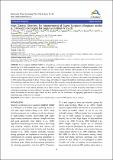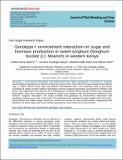| dc.contributor.author | Ochiel, D. C. M. M. Dida, E. Ouma, P. A. Olweny, S. Gudu | |
| dc.date.accessioned | 2022-11-02T18:14:06Z | |
| dc.date.available | 2022-11-02T18:14:06Z | |
| dc.date.issued | 2021 | |
| dc.identifier.issn | 2006-9758 | |
| dc.identifier.uri | https://repository.maseno.ac.ke/handle/123456789/5474 | |
| dc.description.abstract | Sorghum is an important staple food crop in Kenya, but its yield is low due to many constraints which
include diseases, drought, soil fertility, and pests, notably parasitic weed Striga hermonthica. Twenty
elite sorghum genotypes and one resistant check were evaluated in three replications in a complete
randomized design in Agar Gel (AG) experiment and randomized complete block design on selected
Striga hotspot farms at Kadel and Nyahera in western Kenya. Significant differences (p<0.001) were
realized both in the fields (plant height, dry shoot biomass yield, grain yield, field Striga count, and
Striga damage ratings) and in the AG experiment with respect to maximum germination distance
and numbers of induced germinated Striga seeds. Among the sorghum genotypes evaluated
under field conditions, T53B, N57, N68, C26, IESV 92036-SH, T30B, and Uyoma 47 White genotypes
had stable yields under Striga infestation in the two sites, whereas Nyadundo 1, Nyadundo 2, and
Uyoma 8 were susceptible. In the AG experiment, E117B, T30B, Uyoma 8, Uyoma 42 STR, and T53B
induced high numbers of germinated Striga seeds with maximum germination distances (MGD). In
contrast, Uyoma 47 Brown, IESV 92038/2-SH, and IESV 92036-SH sorghum genotypes secreted low
amounts of SLS suggesting resistance. This study has identified and selected four Striga tolerant
(T53B, N68, N57, and T 30B) and resistant (C 26, Uyoma 47 Brown, IESV 92038/2-SH, and IESV 92036-
SH) sorghum genotypes which can be utilized in further research programs or adopted to improve
sorghum productivity in the highly Striga infested regions of western Kenya | en_US |
| dc.publisher | Academic Journals | en_US |
| dc.subject | Striga, sorghum genotypes, resistant, susceptible, tolerant, Agar Gel experimen | en_US |
| dc.title | Sorghum is an important staple food crop in Kenya, but its yield is low due to many constraints which include diseases, drought, soil fertility, and pests, notably parasitic weed Striga hermonthica. Twenty elite sorghum genotypes and one resistant check were evaluated in three replications in a complete randomized design in Agar Gel (AG) experiment and randomized complete block design on selected Striga hotspot farms at Kadel and Nyahera in western Kenya. Significant differences (p<0.001) were realized both in the fields (plant height, dry shoot biomass yield, grain yield, field Striga count, and Striga damage ratings) and in the AG experiment with respect to maximum germination distance and numbers of induced germinated Striga seeds. Among the sorghum genotypes evaluated under field conditions, T53B, N57, N68, C26, IESV 92036-SH, T30B, and Uyoma 47 White genotypes had stable yields under Striga infestation in the two sites, whereas Nyadundo 1, Nyadundo 2, and Uyoma 8 were susceptible. In the AG experiment, E117B, T30B, Uyoma 8, Uyoma 42 STR, and T53B induced high numbers of germinated Striga seeds with maximum germination distances (MGD). In contrast, Uyoma 47 Brown, IESV 92038/2-SH, and IESV 92036-SH sorghum genotypes secreted low amounts of SLS suggesting resistance. This study has identified and selected four Striga tolerant (T53B, N68, N57, and T 30B) and resistant (C 26, Uyoma 47 Brown, IESV 92038/2-SH, and IESV 92036- SH) sorghum genotypes which can be utilized in further research programs or adopted to improve sorghum productivity in the highly Striga infested regions of western Kenya. | en_US |
| dc.type | Article | en_US |


